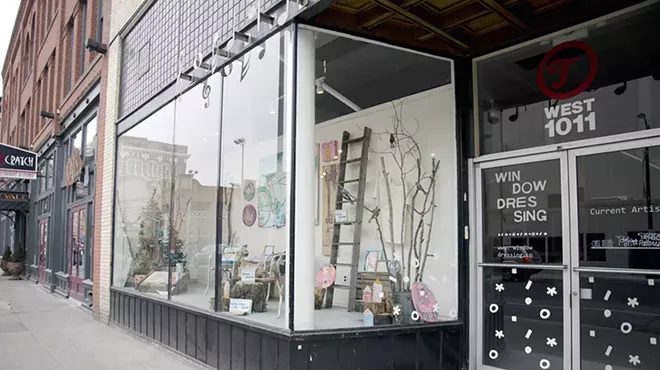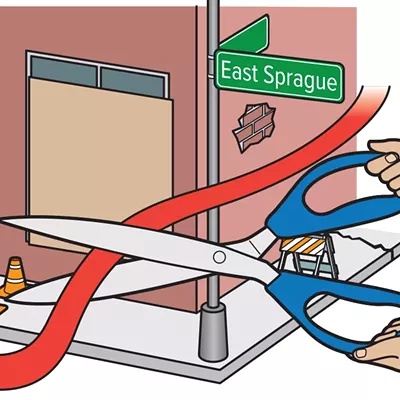A broken window delayed the debut, but soon the patchwork of butcher paper and plastic covering the front windows of the Music City building on First Avenue will come down, revealing a project that could solve Spokane's problem with vacant buildings.
Imagine the allure of a classic department store window display. Now add the work of local artists.
Aside from the couple of weeks each fall when Terrain takes over the building, it's been vacant for years. So almost a year ago, a building owner approached Terrain co-founder Ginger Ewing about doing something to make it look better year-round. It's one example of a growing idea, in Spokane and cities worldwide, that a vacant building doesn't need to look vacant.
"It started as a simple concept, and has grown into potentially a much bigger project," Ewing says.
Variations on the street-facing gallery have been popping up all over: In Vancouver, Wash., the Windows Into Art exhibit turned the street into a museum by putting contemporary art into unused windows in 2010; a similar program called "Windows Alive" started in Yakima this year. It's been used in tiny towns to brighten Main Street, big cities like San Francisco and Seattle and struggling suburbs of Chicago. Sometimes the projects are aided by cities and official arts groups, but remarkably often they're started by tiny nonprofits, student art clubs or a single person.
A notable success story is what happened in Newcastle, Australia, a struggling manufacturing city plagued by lifeless, decaying areas. Started in 2008, an initiative called Renew Newcastle negotiated short-term leases with property owners of underused buildings, allowing artists and other creative endeavors to use the space for cool things. A 2011 report determined that every dollar invested in the program ultimately generated at least $10 in economic activity for the city.
The benefits are threefold: Artists get their work seen, building owners are more likely to find tenants or investors, and surrounding businesses — like the restaurants and boutiques on the Music City block — have a more attractive neighborhood.
"It's only going to benefit them if that storefront is not vacant," Ewing says.
On the other side of downtown Spokane, Alan Chatham has been experimenting with interactive art displayed in the windows of Laboratory, his space at the corner of Main and Bernard, and thinking about how art can be used to get people walking. The way he sees it, downtown Spokane has pockets of exciting, creative things happening. The trick is to create a conduit that guides people between them.
He and Ewing have been talking — this is where the idea gets big — about creating a corridor that carries visitors from one lively part of town to another by getting art into other empty storefronts on First Avenue.
"All of a sudden you have this cohesive stretch of targeting window spaces that are bright at night," he explains. "Even if it's the same amount of pedestrians walking down the street, it doesn't feel so lonely; it doesn't feel so isolated."
Chatham sees the former location of Scout on the corner of First and Monroe as a "no-brainer" — welcoming guests to a hotel above a cool, pop-up art gallery sounds obviously better than a hotel above an empty former restaurant.
"Even if the gallery's not paying rent, it's making the space more attractive to potential future clients," he says. ♦




















